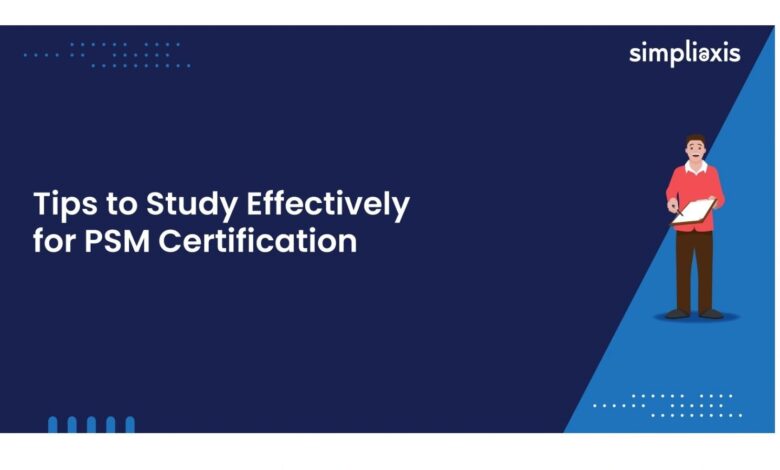Tips to Study Effectively for PSM Certification

Scrum is an agile framework encouraging team collaboration commonly practiced in software development, and nowadays applied in many other industries as well. There are a lot of board agile education bodies available in today’s global market. Scrum.org is considered as the Home of Scrum, was founded by Scrum co-creator Ken Schwaber as a mission-based organization to help people and teams solve complex problems.
This Scrum.org primarily focuses on the Scrum framework, promoting and supporting “Professional Scrum “ practices among team members of the organization. It offers a variety of certifications and Professional Scrum Master Certifications are one of them. Here in this article we can look about what PSM is and effective tips to study for this certification preparation.
Understanding PSM Certification:
PSM Certification, in full form Professional Scrum Master™ offered by Scrum.org, authenticates how well you know Scrum and the roles of Scrum Master specifically in Agile environments. This certification has three levels ((PSM I, PSM II, and PSM III)) from beginner to expert level.
The knowledge gained from this PSM certification course helps individuals to understand scrum practices and values and how they would react to challenging situations.
Who are eligible to take this certification:
This course is suitable for existing professionals who practice Scrum, want to be certified to show their competency to organisations or new people entering into the Agile practices, here some of the professionals are eligible to take this certification.
- Team Members
- Project Managers
- Scrum Masters
- Product Managers
- Software Developers
- Team Leads/Team Members
- Developers
- Product Owners
- Anyone with an interest in Agile and Scrum.
Eligibility Criteria:
Before taking this course, be sure to check PSM I Certification Eligibility requirements. To become a PSM I Certified professional, there are no strict prerequisites needed.You just need to attend the 16 hours of PSM Certification training and need to pass an assessment consisting 80 Questions within a time limit of 60 minutes and passing score is 80% to achieve this certification.
Certification Details:
Each attempt for this certification assessment costs around $200. The exam has Multiple Choice, Multiple Answer, True/False format. Passwords offered to take this exam do not expire, but can be valid for only one attempt. This certification has lifetime validity, so there is no annual renewal and fee required.
Tips to Study Effectively for PSM Certification:
There are a lot of tips and guidance needed to follow to clear PSM I Certification on the first attempt. Let’s see one by one.
Understand the Scrum Basics:
Strong yourself in fundamentals Scrum concepts such as Scum Roles, Scrum Events, Artifacts, Values. And let’s clearly understand what Scrum Framework is and how Scrum works.
Understand the Scrum Guide:
Scrum Guide is the official Scrum body of knowledge, developed by Ken Schwaber and Jeff Sutherland, the originators of Scrum. This official document about Scrum contains information about Scrum Definition, Scrum Theory, Transparency, Adaptation, Scrum Values (Commitment, Focus, Openness, Respect, and Courage), Scrum Team, Scrum Events, Scrum Artifacts. Making the habit of reading it daily makes you have a perfect understanding of the scrum concepts.
Practice Scrum:
Scrum Framework is simple and it focus and work on 3-5-3 structure: 3 roles (Product Owner, Scrum Master, Development Team), 5 events (Sprint Planning, Daily Scrum, Sprint Review, Sprint Retrospective, and the Sprint), and 3 artifacts (Product Backlog, Sprint Backlog, and Increment). To know how these elements are functioning, why because these are important to successfully practice Scrum in your work and organization.
Understand the Focus Areas:
PSM I exam has questions included from the below focus areas which all are defined in Professional Scrum Competencies prescribed by Scum.org.
- Understanding and Applying the Scrum Framework:
- Empiricism,
- Scrum Values,
- Scrum Team, Events,
- Artifacts,
- Done
- Developing People and Teams:
- Self-Managing Teams,
- Facilitation,
- Coaching
- Managing Products with Agility:
- Forecasting & Release Planning,
- Product Value,
- Product Backlog Management,
- Stakeholders & Customers
So preparing these focus areas help you to face the exam confidently.
Complete the scrum open assessment:
Scrum.org offers Open assessment options to real environment exam practice tests. It is a useful resource to measure your understanding of scrum and PSM I Certification syllabus. This is offered free of charge, but does not include the certification.
Read questions carefully:
While taking the exam, it is important to pay close attention to the wording and be sure about thoroughly understanding what types of questions are asked for. Always be careful about particular Negative Questions through notes like “ NOT”. If anything Bold, Italicized in the questions give hints about selection of answers. Understand the question formats, here PSM certification exams have mostly Multiple Choice, Multiple Answer, True/False questions types.
Answering Techniques:
To improve your chances of correct answering with MCQs, first, read the question and all the answer choices closely. Then, cross out the ones that are clearly wrong. If you are still not sure, take your best answers using what you know or any hints you can find in the question.
When answering true/false questions, read carefully, dissect statements, look for absolutes and qualifiers, and be mindful of negatives, especially double negatives.
Answer all the questions, as this assessment has no negative markings and it makes chances of improving your score.
By following these answering techniques helpful to answer quickly and effectively.
Time Management:
Managing time in the exams is a really challenging one. You cannot achieve proper time management without practice. So take multiple practice mock exams that resonate with real exams under timed conditions. Familiarize yourself with exam format and question types, create a strategic approach to answer easier questions first and unsure questions postponed to later. Stick to the point and avoid unnecessary details.
Final Thoughts:
If you follow these tips to succeed in your certification journey. Additionally Here some more tips need to follow as Look over your notes each day to reinforce the material. Note what questions you got wrong from practice exams (either in flashcards or jot them down) to review so you don’t make the same mistakes on your certification. The main material of the exam is the Scrum Guide. So, I highly recommend reading this at least 2-3 times and knowing it well.
By following these tips and dedicating sufficient time to study and practice, you can increase your chances of passing the PSM I exam on your first attempt




